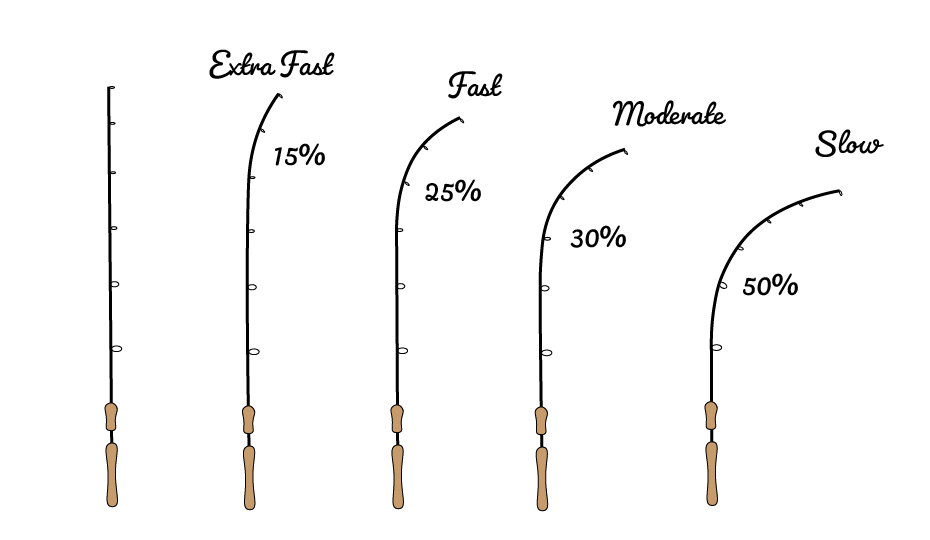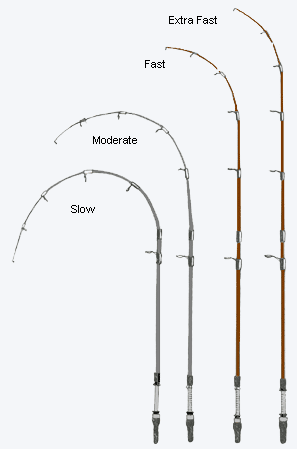Fishing is an activity that requires skill, patience, and the right equipment. One of the essential tools for any angler is the fishing rod. A fishing rod is more than just a long stick; it is a complex piece of equipment with many different parts and features. One of the most important aspects of a fishing rod is its action.
Fishing rod action refers to how much the rod flexes and bends when pressure is applied to the tip. The action of a fishing rod determines how sensitive it is to a fish biting, how far you can cast, and how much control you have over the fish once it’s hooked. Understanding fishing rod action is crucial for any angler who wants to improve their fishing skills and catch more fish. In this article, we will explore what fishing rod action is, how it works, and why it’s essential for successful fishing.
Fishing rod action refers to how much the rod bends when pressure is applied. It is determined by the placement and stiffness of the rod’s guides and its taper. A fast action rod bends mostly near the tip, while a slow action rod bends throughout the entire blank. Medium action rods fall somewhere in between. Understanding rod action is important for selecting the right rod for your fishing needs.

Understanding Fishing Rod Action: A Beginner’s Guide
Fishing is an activity that requires a lot of patience, skill, and knowledge. One of the most important things to understand when it comes to fishing is the fishing rod action. Fishing rod action refers to the amount of bend or flex a fishing rod has when pressure is applied to it. In this article, we will discuss everything you need to know about fishing rod action.
What is Fishing Rod Action?
Fishing rod action is the amount of bend or flex a fishing rod has when pressure is applied to it. There are three main types of fishing rod action: fast action, medium action, and slow action. Fast action rods have the least amount of bend and are typically used for fishing in open water or for catching larger fish. Medium action rods have a moderate amount of bend and are ideal for fishing in freshwater or for catching smaller fish. Slow action rods have the most bend and are best used for fishing in small streams or for catching very small fish.
When it comes to fishing rod action, it’s important to choose the right type of rod for the type of fish you’re trying to catch. If you’re fishing for larger fish in open water, a fast action rod is the best option. If you’re fishing for smaller fish in freshwater, a medium action rod is the way to go. And if you’re fishing in small streams or for very small fish, a slow action rod is the best choice.
The Benefits of Different Fishing Rod Actions
Each type of fishing rod action has its own benefits. Here are some of the benefits of each type of fishing rod action:
Fast Action
– Provides more power and control when casting
– Ideal for fishing in open water
– Can handle larger fish
Medium Action
– Offers a good balance between power and flexibility
– Ideal for fishing in freshwater
– Great for catching smaller fish
Slow Action
– Provides the most flex and sensitivity
– Ideal for fishing in small streams
– Best for catching very small fish
Fishing Rod Action vs Power: What’s the Difference?
Fishing rod action and power are often confused, but they are actually two different things. Fishing rod power refers to the amount of force needed to bend the rod, while fishing rod action refers to the point on the rod where the bend occurs.
Here’s a breakdown of the differences between fishing rod action and power:
– Fishing rod action: Refers to the point on the rod where the bend occurs
– Fishing rod power: Refers to the amount of force needed to bend the rod
– Fast action rod: Requires more force to bend, but bends less
– Slow action rod: Requires less force to bend, but bends more
Fishing Rod Action and Casting Distance
Fishing rod action can also affect casting distance. Fast action rods are ideal for long distance casting because they provide more power and control. Slow action rods are not ideal for long distance casting because they have more flex and can’t provide the same level of power and control as fast action rods.
Fishing Rod Action and Lure Presentation
Fishing rod action can also affect lure presentation. Fast action rods are ideal for fishing with lures because they provide more power and control, which allows you to make more precise casts. Slow action rods are not ideal for fishing with lures because they have more flex, which can make it more difficult to make precise casts.
Fishing Rod Action and Sensitivity
Fishing rod action can also affect sensitivity. Slow action rods are the most sensitive because they have the most bend, which allows you to feel even the slightest movements in the water. Fast action rods are the least sensitive because they have the least amount of bend.
Fishing Rod Action and Line Weight
Fishing rod action can also affect line weight. Fast action rods are typically designed to handle heavier line weights, while slow action rods are designed to handle lighter line weights. It’s important to choose a rod with the appropriate line weight for the type of fish you’re trying to catch.
Fishing Rod Action and Rod Length
Fishing rod action can also affect rod length. Fast action rods are typically shorter in length, while slow action rods are longer. This is because fast action rods are designed for power and control, while slow action rods are designed for flexibility and sensitivity.
Conclusion
Fishing rod action is an important factor to consider when choosing a fishing rod. Whether you’re fishing in open water, in freshwater, or in small streams, there is a fishing rod action that is right for you. By understanding the benefits of each type of fishing rod action, you can choose the right rod for your needs and increase your chances of catching the fish you’re after.
Key Takeaways on Fishing Rod Action
- Fishing rod action refers to how the rod bends and flexes when casting and reeling in a fish.
- There are several types of fishing rod action, including slow, medium, and fast action.
- Slow action rods are more flexible and are better for catching smaller fish or when using lighter lures.
- Medium action rods are versatile and can be used for a variety of fishing techniques and fish sizes.
- Fast action rods are stiffer and are better for catching larger fish or when using heavier lures.
- The length of a fishing rod can also affect its action, with longer rods typically having a slower action.
- Choosing the right fishing rod action depends on the type of fish you’re targeting, the fishing technique you’re using, and the size of the lure you’re using.
- Understanding fishing rod action can help you become a more successful angler by allowing you to select the right rod for the job.
In summary, fishing rod action is an important factor to consider when selecting a fishing rod. By understanding the different types of rod action, you can choose the right rod for the type of fishing you’re doing, which can increase your chances of catching more fish. Remember to consider the size of the fish, the type of lure you’re using, and the fishing technique you’re employing when selecting a fishing rod with the appropriate action.

Fishing Rod Power VS Action
As a professional writer, I can confidently say that understanding fishing rod action is crucial for any angler. Fishing rod action refers to the flexibility of the rod and how it bends when pressure is applied to it. It plays a vital role in determining the type of fish you can catch and the technique you can use to catch them. A fishing rod with a fast action bends mostly at the top, while a slow action rod bends throughout its length. Understanding these characteristics can help you choose the right rod for your fishing needs and increase your chances of catching fish.
In conclusion, fishing rod action is an essential factor for any angler to consider. It determines the sensitivity, power, and versatility of the rod, which ultimately affects your fishing experience. By understanding the differences in rod action and choosing the right one for your needs, you can improve your chances of catching fish and make your fishing experience more enjoyable. So, whether you’re a beginner or a seasoned angler, taking the time to learn about fishing rod action can be the key to your fishing success.
